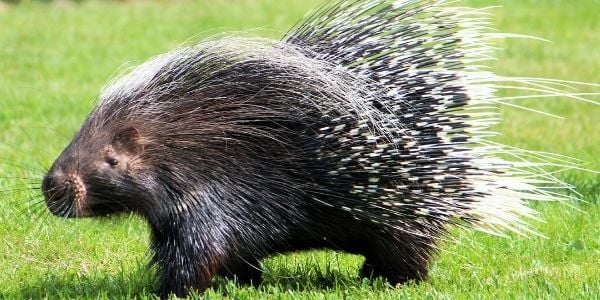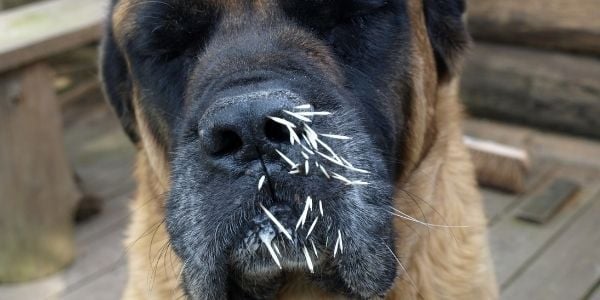
We all know the proverb, “Curiosity killed the cat, but satisfaction brought it back.” What I don’t understand is why there isn’t one about dogs and their curiosity.
For anyone who has a dog or has been around them, you know just how curious (and nosey) they are. Plus, that curiosity often gets them in a lot of trouble. This is especially true when they get curious about porcupines.
Cats seem to learn from their mishaps relating to their curiosity, but for some reason, especially with porcupines, dogs don’t seem to. This is based on my experience that most dogs are repeat offenders when it comes to porcupine attacks. Perhaps they get some satisfaction in thinking they won the battle when they get a face full of quills.
What Is the Deal With Porcupine Quills?
Porcupine & Dog Facts
- These rodents weigh between 15 to 35 pounds.
- They have poor eyesight but a great sense of smell.
- Porcupines are herbivores with a diet of fruits, nuts, and twigs.
- Porcupines are nocturnal, but they often are active before the sun goes down during the summer due to longer days.
- There are far fewer dog/porcupine encounters during the winter months – as the days are shorter, and they spend more time in their den.
Due to movies and cartoons, many people think that porcupines shoot out their quills at would-be attackers. But in reality, that isn’t the case. The long quill is actually a hair. It's covered with protein keratin that makes it hard and sharp.
A porcupine can have up to 30,000 quills! The end of the quill has a barb on it that easily attaches to the skin of predators, and the barb allows the quill to migrate (digging deeper into the skin) once embedded.
As I mentioned, this warrior rodent doesn’t shoot out their quills like missiles from afar. They use them in two ways for self-defense.
One, they use their tail like a club and swing it so the barbed end becomes attached to their attacker.
Second, when they feel threatened, they raise them up on their back. Since the quill ends are barbed, when they make contact with your dog, they quickly detach from the porcupine and attach deeply into your dog’s skin, causing immediate and severe pain.
Unfortunately, that contact is mostly to the face and the quills get solidly anchored. And the removal of the quills is difficult and painful for your dog.
There is more bad news about the quills. They become more anchored in the skin the longer they are there. This is because body heat causes their expansion, and the quills can become life-threatening as they migrate further into your dog's body. They can migrate to vital organs and cause injury by piercing them. It is not uncommon for infections to develop because the quill acts like a needle for injecting bacteria.
To make matters worse, your dog’s first reaction is to immediately rub their face on anything they can. All this does is drive the quills deeper into their skin.
What Do You Do After a Porcupine Attack?
As hard as it will be, don’t panic. Your first few actions following the attack are important.
- Get your dog away from the porcupine (they don’t need more quills).
- Be careful not to touch any quills yourself.
- Do not let your dog rub any area where the quills are embedded, and get to your nearest veterinarian immediately.
- That all sounds simple – NOT! Just do your best. The most important thing is to get to a veterinarian.
Do Not Attempt to Remove the Quills on Your Own
Not only is the process very painful for your dog, which puts you at risk of getting bitten, but it can also create significant complications for your dog. If the quill ends up breaking off in your dog’s skin, your dog will likely end up with an abscess. Broken quills swell and splinter. If multiple quills get left in the skin and abscesses develop, your dog can end up with a body-wide infection. This could be fatal.
Additionally, the quill can migrate deeper into the body and potentially pierce and damage not only vital organs but blood vessels as well. The sooner you get to a veterinarian, the better. The longer the quills are embedded, the more brittle and rigid they get. This can complicate their removal.
How Veterinarians Remove Porcupine Quills from Dogs
The veterinarian will need to heavily sedate or place your dog under general anesthesia to remove the quills. There are times when the quills are deeply embedded, and an ultrasound may be necessary to locate them. Other times, especially if large areas are affected, quills have broken off, or if there was a delay in treatment, a CT scan is needed to ensure complete removal of all quills.
The length of time for removal and the difficulty of the removal will depend on the number of quills, the location of the quills, how many have been broken off, and the length of time the quills have been in the skin.
Follow your veterinarian's discharge instructions closely. Be sure to administer and finish all medications as they are prescribed. This will likely include antibiotics, pain medication, and possible wound flush or ointment. Be sure to monitor any incisions closely for redness, swelling, or discharge. If you notice any of these signs or your dog doesn't seem to be improving, contact your veterinarian.
Your dog will likely be painful and swollen for a few days following the procedure. Allow them plenty of peace and quiet, and be sure they have a soft place to rest.
Since there may be surgical sites and sutures, it will likely be a 10 to 14-day recovery period. Do not bathe your dog until the sutures, if present, have been removed and you have approval from your veterinarian to do so.
Since it is possible that some quills could not be removed, monitor your dog closely for at least two weeks following the attack. Look for any redness, swelling, or painful locations on the skin.
Unfortunately, there are times when some quills cannot be removed. This can be due to the fact that they were embedded too deep or they broke off and could not be found. This will require you to diligently monitor your dog for at least two weeks following the attack for any signs of infection or health issues. Some potential complications are as follows:
- Deep tissue infections
- Migrating quills – they can enter joints, eyes, brain, and other organs
- Death
How to Protect Your Dog From Porcupines
Prevention is the key to protection. Many dogs are repeat offenders when it comes to porcupine curiosity or predation. Dogs are curious predators after all. But you can take steps to prevent encounters and teach your dog what to do instead when they see a porcupine.
- Do not let your dog roam at dusk or dawn.
- Do not let your dog go into areas with known porcupine dens. Porcupines tend to reuse the same den year after year, so if you've had them in your area before, you'll likely have them again the following year.
- Keep your dog on a leash/harness while walking or hiking, especially in the woods or field edges. Remember, this is important during the summer months when days are longer.
- If you live in porcupine country, teach your dog how to avoid porcupines — this can be done through positive reinforcement training, much like snake aversion training.
- Teach your dog an emergency recall behavior. While your dog may come when called for the most part with their regular cue, having an emergency recall cue can be especially beneficial for high distraction and dangerous moments, such as when your dog takes interest in a porcupine.




